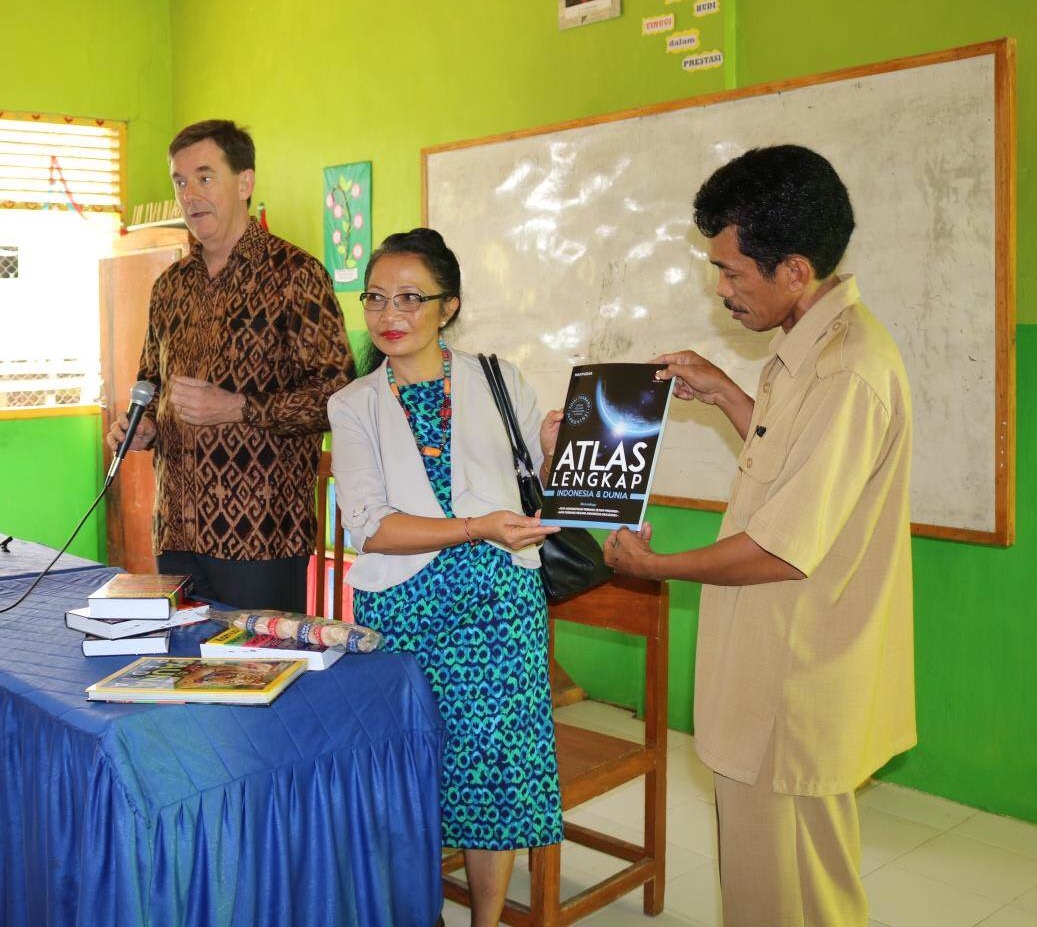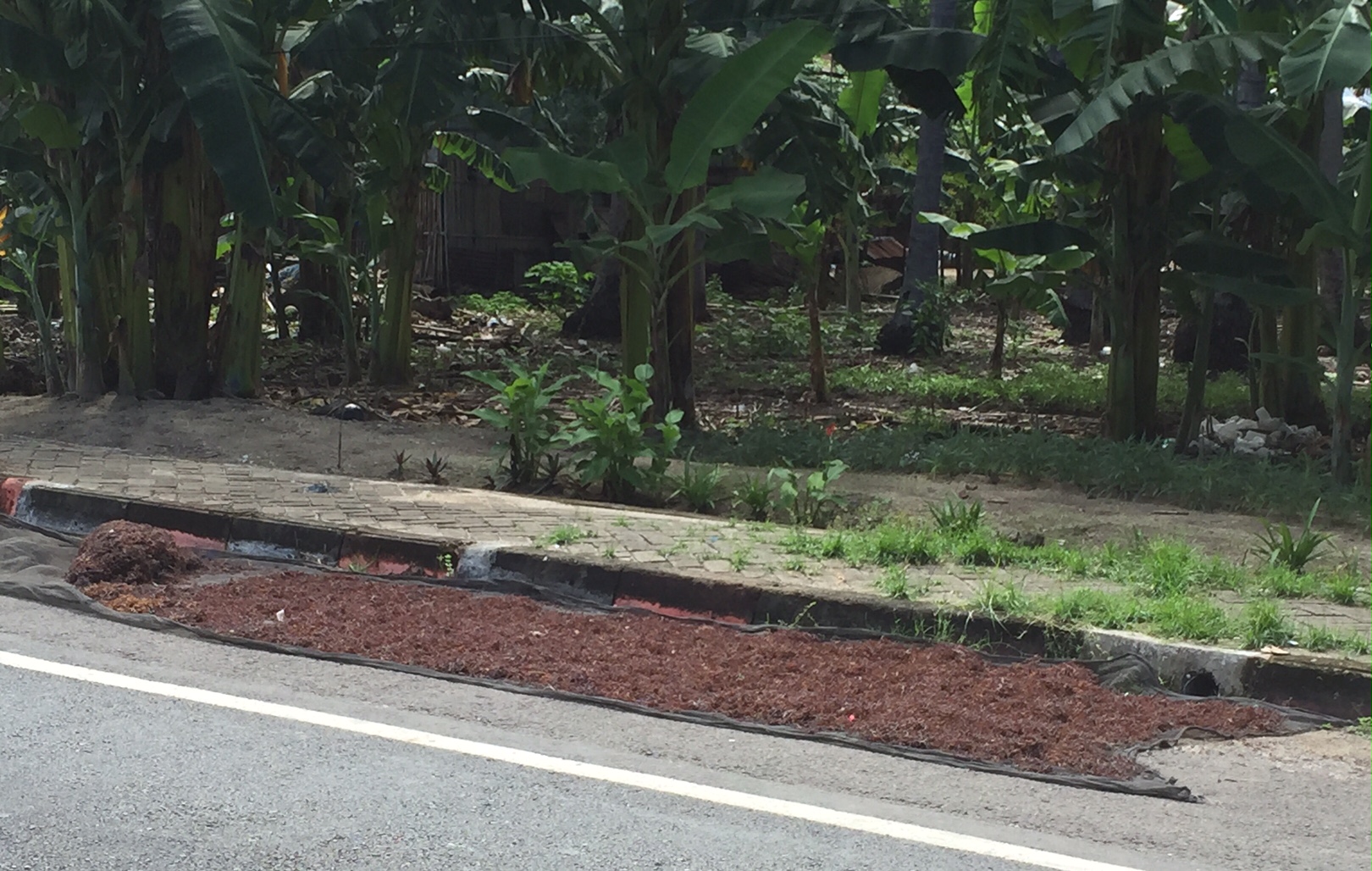We recently visited two schools in Bulukumba, in the southeast of South Sulawesi, to donate books that we hope will help the teachers and students. The two schools we visited were Madrasahs, community-run Islamic schools accredited under the Ministry of Religion education system. Most of the students were children of farmers and fisher folk. Both these schools have benefitted from an Australian aid program which provided around Rp100 million per school to support upgrading programs and accreditation in eight essential areas, including the building of school libraries and provision of a basic set of school books.
Every time we visit a school now we ask to see the library. Usually there are very few books, and those that are frequently used are dog-eared and falling apart. The teachers tell us that they don’t have enough money to buy every student all the text books they need; and there is no way farmers and fisher folk families can afford school text books for their children. As we discovered recently, buying a full set of national curriculum text books from the local Gramedia book chain for one student for one year costs over Rp 1million – beyond the capability of most farmers and fishermen.
So last Sunday we set out on the five hour journey to Bulukumba with around 100 books, including some dictionaries, atlases and colourful books about animals and plants.

Atlases are really good, Madrasah Badan Amal
Along the way we passed through the districts of Gowa, Takalar, Jeneponto and Bantaeng. Gowa was once the seat of the major kingdom in South Sulawesi, which adopted Islam in the early 1600s. The Gowa kingdom claimed to have conquered northern Australia in around 1640, before itself being conquered by the Dutch in 1669.
Takalar is a relatively new district (or kabupaten) and produces a lot of rice, corn and other agricultural products. All along the south coast people also harvest large amounts of seaweed for export, and farm fish and prawns.
Jeneponto looked much poorer than the other districts, but along the road side there was much for sale, including bags of locally-made salt, bottles of cloudy white of tuak (palm wine), watermelons, and Jenponto’s signature dish – coto kuda, or horse soup. Yes, the Jenepontians eat horse and are proud of it.
From Jeneponto and through to Bulukumba the road became relatively smooth and pothole-free. We were now travelling on a road built with Australian aid under the East Indonesia National Road Improvement Program (EINRIP), a road that the Vice President has praised as a model for all future roads in the eastern provinces.

Aussie built road in SulSel - hard shoulders are useful, e.g. for drying seaweed
We passed through Bantaeng relatively quickly. This small district is a model of cleanliness and good public services. Its Bupati, Nurdin Abdullah, has been featured in Bloomberg news as an innovative and go-getting local leader who has attracted foreign investment into his district. Indeed, I visited a Chinese-built nickel smelter in Bantaeng a few weeks ago. The nickel ore will be shipped from Southeast Sulawesi to the smelter’s own little jetty, turned into ferronickel (using huge amounts of electricity) and then trucked to Makassar for export to Shanghai. I also marvelled at local plans to develop a large gas-electric power plant, and other industrial developments in the middle of this rather isolated district.
Our destination district, Bulukumba, is famous for its beauty. Bira, at the very southeast tip of the South Sulawesi peninsula, is famed for its beautiful beaches and great coral cliffs. It was also once famous for its beautiful coral reefs, until they were largely destroyed by fish-bombing. The bombing has now stopped and hopefully the reefs will begin to grow back. Bira and the nearby white-sand beach of Bara, is very popular with holidaymakers from Makassar. There are a lot of small homestays along the beach, and beach parties, banana boat rides and diving are the popular pastimes.
The two schools we visited were Sekolah Satu Atap Benjala and Madrasah Tsanawiyah Badan Amal. The Benjala school was about ten minutes off the main road through several pretty kampongs and coconut plantations. We visited the junior high school section which has a student body this year of 69. Only the Principal is a fully-paid public servant. The other teachers are all “guru honorer”, meaning they are paid small stipends to cover little more than the cost of motor cycle petrol to get to work. They have to serve at least two years of full-time teaching before they can hope to begin the accreditation process as a teacher. Achieving full accreditation - and a full range of salary and allowances - can take many years.
We handed over our books to the Principal in the library then I gave a little pep talk to the new students in year 7: study well and look after these books so they last a good while. Enjoy your new school, it is in a lovely setting and your teachers are dedicated and work hard for you.
Madrasah Tsanawiyah Badan Amal is a larger school backing on to the beach. Here I explained to around 200 students the value of the books I was handing over, and I tested their knowledge of geography and handed out little toy koalas to the students who got the answers right. One aspiring young geographer won two koalas and the admiration of his school friends. He knew the capital of Australia, and the name of the great cold land south of Australia (and no adults yelled out Madagascar this time).
Bright young minds learning about Australia (and Antarctica), Madrasah Badan Amal
Young Indonesians are growing up in a much improved education system today compared to that experienced by their parents. But there is a widely acknowledged “reading crisis” in Indonesian schools: kids just don’t read books. Top-down attempts to enforce 15 minutes of reading time per day before class have had questionable effect. Various government and foreign aid programs have also attempted to encourage a schools-based reading culture, but their results are yet to be analysed.
A koala for you, young man! Madrasah Benjala, new year 7 students
I cannot with confidence say whether handing books out to poor school libraries will have any impact on children’s interest in reading and knowledge, but if just a few kids’ interest in further learning is stimulated then it is, I suppose, a benefit. But some teachers have said to me that if they had to choose, they would prefer to be given more photocopy machines so that they could more easily reproduce their own lesson materials. I will keep that in mind!
Certainly in a country with some 50 million school children and around 300,000 schools, developing a reading culture and improving literacy rates is a major challenge – and success would have amazing benefits to the nation.
***
